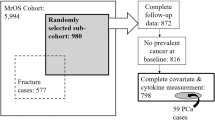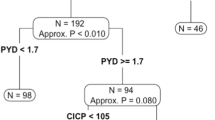Abstract
The clinical significance of serum interleukin-6 (IL-6) and its correlation with cystatin C (Cyst C), an endogenous inhibitor of cysteine proteinase cathepsin K, was investigated by immunoassays in patients with bone metastasis from breast cancer (BCa) or prostate cancer (PCa). Additional studies were also performed in these patients to assess the effects of zoledronic acid (ZA) administration on the circulating levels of these molecules. Mean IL-6 and Cyst C serum concentrations were significantly increased in BCa patients and in patients with primary osteoporosis (PO) compared to healthy subjects (HS). However, Cyst C, but not IL-6, resulted significantly more elevated in BCa patients than in PO patients. Furthermore, in BCa patients no correlation was highlighted between IL-6 and Cyst C or between these molecules and some clinicobiological parameters of malignant progression. Mean IL-6 levels were also higher in PCa patients and in patients with benign prostatic hyperplasia (BPH) than in HS while Cyst C resulted significantly higher in PCa but not in BPH patients as compared to HS. In PCa patients, a positive correlation was highlighted between IL-6 and number of bone metastases or serum prostate-specific antigen but not with the Gleason score. Conversely, Cyst C levels did not correlate with any of the parameters considered above or with IL-6. Receiver operating characteristic (ROC) curve analysis showed a poor diagnostic accuracy of IL-6 and Cyst C to detect BCa patients with skeletal metastases while, in PCa patients, only IL-6 showed a fair diagnostic performance in this respect. Finally, the administration of ZA to patients with bone metastases induced a statistically significant increase of serum IL-6 and Cyst C only PCa patients with bone metastasis. These data indicate that IL-6 and Cyst C may be regarded as novel targets for cancer treatment and as markers of increased osteoblastic activity associated to bisphosphonate treatments in PCa patients with bone metastases.

Similar content being viewed by others
References
Hong DS, Angelo LS, Kurzrock R. Interleukin-6 and its receptors in cancer. Implication for translational therapeutics. Cancer. 2007;110:1911–28. Review.
Franchimont N, Wertz S, Malaise M. Interleukin-6: an osteotropic factor influencing bone formation? Bone. 2005;37:601–6.
Kwan Tat S, Padrines M, Théoleyre S, Heymann D, Yannick F. IL-6, RANKL, TNFalpha/IL-1: interrelations in bone resorption pathophysiology. Cytokine Growth Factor Rev. 2004;15(1):49–60.
Knüpfer H, Preiss R. Significance of interleukin-6 in breast cancer. Breast Cancer Res Treat. 2007;102:129–35. Review.
Salgado R, Junius S, Benoy I, Van Dam P, Vermeulen P, Van Marck E, et al. Circulating interleukin-6 predicts survival in patients with metastatic breast cancer. Int J Cancer. 2003;103(5):642–6.
Culig Z, Steiner H, Bartsch G, Hobisch A. Interleukin-6 regulation of prostate cancer cell growth. J Cell Biochem. 2005;95:497–505.
Shariat SF, Andrews B, Kattan MW, Kim J, Wheeler TM, Slawin KM. Plasma levels of interleukin-6 and its soluble receptors are associated with prostate cancer progression and metastasis. Urology. 2001;58:1008–15.
Brage M, Lie A, Ransjö M, Kasprzykowski F, Kasprzykowska R, Abrahamson M, et al. Osteoclastogenesis is decreased by cysteine proteinase inhibitors. Bone. 2004;34(3):412–24.
Lecaille F, Brömme D, Lalmanach G. Biochemical properties and regulation of cathepsin K activity. Biochimie. 2007;90(2):208–26.
Virk MS, Lieberman JR. Tumor metastasis to bone. Arthritis Res Ther. 2007; 9 Suppl 1:S5. doi:10.1186/ar2169.
Neville-Webbe H, Coleman RE. The use of zoledronic acid in the management of metastatic bone disease and hypercalcaemia. Palliat Med. 2003;17(6):539–53.
Fulfaro F, Leto G, Badalamenti G, Arcara C, Cicero G, Valerio MR, et al. The use of zoledronic acid in patients with bone metastases from prostate carcinoma: effects on analgesic response and bone metabolism markers. J Chemother. 2005;17(5):555–9.
Leto G, Badalamenti G, Arcara C, Crescimanno M, Flandina C, Tumminello FM, et al. Effects of zoledronic acid on proteinase plasma levels in patients with bone metastases. Anticancer Res. 2006;26(1A):23–6.
World Medical Association Declaration of Helsinki. Ethical principles for medical research involving human subjects. Bull World Health Organ. 2001;79(4):373–4.
Chen T, Berenson J, Vescio R, Swift R, Gilchick A, Goodin S, et al. Pharmacokinetics and pharmacodynamics of zoledronic acid in cancer patients with bone metastases. J Clin Pharmacol. 2002;42(11):1228–36.
Hanely JA, McNeil BJ. The meaning and use of the area under a receiver operating characteristic (ROC) curve. Radiology. 1982;143:29–36.
Hanley JA, McNeil BJ. A method of comparing the areas under receiver operating characteristic curves derived from the same cases. Radiology. 1983;148:839–43.
Roos JF, Doust J, Tett SE, Kirkpatrick CM. Diagnostic accuracy of cystatin C compared to serum creatinine for the estimation of renal dysfunction in adults and children—a meta-analysis. Clin Biochem. 2007;40(5–6):383–91. Review.
Royuela M, Ricote M, Parsons MS, García-Tuñón I, Paniagua R, de Miguel MP. Immunohistochemical analysis of the IL-6 family of cytokines and their receptors in benign, hyperplasic, and malignant human prostate. J Pathol. 2004;202:41–9.
Michalaki V, Syrigos K, Charles P, Waxman J. Serum levels of IL-6 and TNF-alpha correlate with clinicopathological features and patient survival in patients with prostate cancer. Br J Cancer. 2004;90(12):2312–6.
Jiborn T, Abrahamson M, Gadaleanu V, Lundwall A, Bjartell A. Aberrant expression of Cystatin C in prostate cancer is associated with neuroendocrine differentiation. Br J Urol Int. 2006;98:189–96.
Keppler D. Towards novel anticancer strategies based on cystatin function. Cancer Lett. 2006;235:159–76. Review.
Vigneswaran N, Wu J, Muller S, Zacharias W, Narendran S, Middleton L. Expression analysis of cystatin C and M in laser-capture microdissectioned human breast cancer. Pathol Res Pract. 2005;200 (11–12):753–62.
Kos J, Werle T, Lah T, Brünner N. Cysteine proteinases and their inhibitors in extracellular fluids: markers for diagnosis and prognosis in cancer. Int J Biol Markers. 2000;15:84–9.
Scheidt-Nave C, Bismar H, Leidig-Bruckner G, Woitge H, Seibel MJ, Ziegler R, et al. Serum interleukin 6 is a major predictor of bone loss in women specific to the first decade past menopause. J Clin Endocrinol Metab. 2001;86(5):2032–42.
Kramer G, Mitteregger D, Marberger M. Is benign prostatic hyperplasia (BPH) an immune inflammatory disease? Eur Urol. 2007;51(5):1202–16.
Lerner UH, Johansson L, Ranjsö M, Rosenquist JB, Reinholt FP, Grubb A. Cystatin C, an inhibitor of bone resorption produced by osteoblasts. Acta Physiol Scand. 1997;161(1):81–92.
Danjo A, Yamaza T, Kido MA, Shimohira D, Tsukuba T, Kagiya T, et al. Cystatin C stimulates the differentiation of mouse osteoblastic cells and bone formation. Biochem Biophys Res Commun. 2007;360(1):199–204.
Brand HS, Lerner UH, Grubb A, Beertsen W, Nieuw Amerongen AV, Everts V. Family 2 cystatins inhibit osteoclast-mediated bone resorption in calvarial bone explants. Bone. 2004;35:689–96.
Ferretti G, Fabi A, Carlini P, Papaldo P, Cordiali Fei P. Zoledronic-acid-induced circulating level modifications of angiogenic factors, metalloproteinases and proinflammatory cytokines in metastatic breast cancer patients. Oncology. 2005;69(1):35–43.
Koeneman K, Yeung F, Chung WK. Osteomimetic properties of prostate cancer cells. A hypothesis supporting the predilection of prostate cancer metastasis and growth in the bone environment. Prostate. 1999;39:246–61.
Keller E, Brown J. Prostate cancer bone metastases promote both osteolytic and osteoblastic activity. J Cell Biochem. 2004;9:718–29.
Fromigué O, Body JJ. Bisphosphonates influence the proliferation and the maturation of normal human osteoblasts. J Endocrinol Invest. 2002:25(6):539–46.
Saad F. New research findings on zoledronic acid: survival, pain, and anti-tumour effects. Cancer Treat Rev. 2007;34(2):183–92.
Vogel CL, Yanagihara RH, Wood AJ, Schnell FM, Henderson C, Kaplan BH, et al. Safety and pain palliation of zoledronic acid in patients with breast cancer, prostate cancer, or multiple myeloma who previously received bisphosphonate therapy. Oncologist. 2004;9(6):687–95.
Weinfurt KP, Anstrom KJ, Castel LD, Schulman KA, Saad F. Effect of zoledronic acid on pain associated with bone metastasis in patients with prostate cancer. Ann Oncol. 2006;17(6):986–9.
Acknowledgments
This work was supported by funds from Ministero della Università e Ricerca (MIUR ex quota 60%).
Author information
Authors and Affiliations
Corresponding author
Rights and permissions
About this article
Cite this article
Tumminello, F.M., Badalamenti, G., Incorvaia, L. et al. Serum interleukin-6 in patients with metastatic bone disease: correlation with cystatin C. Med Oncol 26, 10–15 (2009). https://doi.org/10.1007/s12032-008-9070-2
Received:
Accepted:
Published:
Issue Date:
DOI: https://doi.org/10.1007/s12032-008-9070-2




